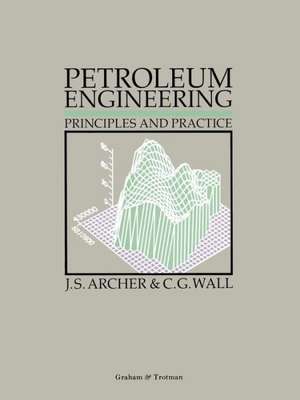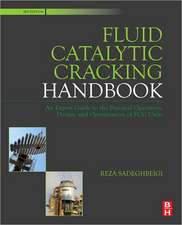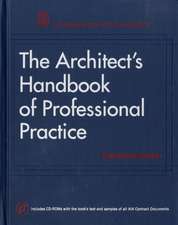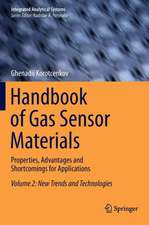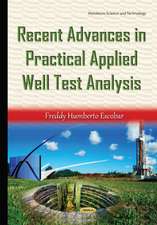Petroleum Engineering: Principles and Practice
J.S. Archer, C.G. Wallen Limba Engleză Paperback – 31 mai 1986
Preț: 406.25 lei
Nou
Puncte Express: 609
Preț estimativ în valută:
77.74€ • 80.64$ • 64.82£
77.74€ • 80.64$ • 64.82£
Carte tipărită la comandă
Livrare economică 27 martie-10 aprilie
Preluare comenzi: 021 569.72.76
Specificații
ISBN-13: 9780860107156
ISBN-10: 0860107159
Pagini: 362
Ilustrații: XI, 362 p.
Dimensiuni: 210 x 279 x 20 mm
Greutate: 0.84 kg
Ediția:Softcover reprint of the original 1st ed. 1986
Editura: SPRINGER NETHERLANDS
Colecția Springer
Locul publicării:Dordrecht, Netherlands
ISBN-10: 0860107159
Pagini: 362
Ilustrații: XI, 362 p.
Dimensiuni: 210 x 279 x 20 mm
Greutate: 0.84 kg
Ediția:Softcover reprint of the original 1st ed. 1986
Editura: SPRINGER NETHERLANDS
Colecția Springer
Locul publicării:Dordrecht, Netherlands
Public țintă
ResearchCuprins
1 Introduction.- 1.1 Petroleum Engineering: A creative technology.- 2 Reservoirs.- 2.1 Conditions for occurrence.- 2.2 Reservoir pressures.- 2.3 Fluid pressures in a hydrocarbon zone.- 2.4 Reservoir temperatures.- 2.5 Nature of reservoir fluids.- 2.6 Reservoir data — sources.- 3 Oilwell Drilling.- 3.1 Operations.- 3.2 Costs.- 3.3 Well completions and oilwell casing.- 3.4 Completion.- 3.5 Drilling fluid control.- 3.6 Rheology of well fluids (drilling muds and cements).- 3.7 Formation breakdown pressures and leak off tests.- 3.8 Data acquisition during drilling.- 3.9 Mud fluids for core recovery.- 3.10 Drilling optimization.- 3.11 Turbine versus conventional rotary.- 3.12 Special problems in drilling.- 3.13 Completion for production.- 4 Properties of Reservoir Fluids.- 4.1 Volumetric and phase behaviour of hydrocarbon systems.- 4.2 Applications to field systems.- 4.3 Compressibility.- 4.4 Measurement and prediction of reservoir fluid properties.- 4.5 Formation volume factors, B.- 4.6 Gas—oil ratios.- 4.7 Direct measurements — PVT analysis.- 4.8 Generalized correlations for liquid systems.- 5 Characteristics of Reservoir Rocks.- 5.1 Data sources and application.- 5.2 Coring decisions.- 5.3 Conventional and oriented coring.- 5.4 Coring mud systems.- 5.5 Core preservation.- 5.6 Well site controls.- 5.7 Core for special core analysis.- 5.8 Core-derived data.- 5.9 Geological studies.- 5.10 Routine core analysis.- 5.11 Porosity.- 5.12 Permeability.- 5.13 Relationships between porosity and permeability.- 6 Fluid Saturation: influence of wettability and capillary pressure.- 6.1 Equilibrium conditions.- 6.2 Laboratory measurements and relationship with reservoir systems.- 6.3 Pore size distribution.- 6.4 Capillary pressure hysteresis.- 6.5 Saturation distributions inreservoir intervals.- 6.6 Correlation of capillary pressure data from a given rock type.- 7 Relative permeability and multiphase flow in porous media.- 7.1 Definitions.- 7.2 Fractional flow.- 7.3 Effects of permeability variation.- 7.4 Wettability effects.- 7.5 Laboratory determination of relative permeability data.- 7.6 Residual saturations.- 7.7 In situ wettability control.- 7.8 Relative permeability from correlations.- 7.9 Validation of relative permeability data for use in displacement calculations.- 7.10 Pseudo-relative permeability in dynamic systems.- 7.11 Static pseudo-relative permeability functions.- 8 Representation of volumetric estimates and recoverable reserves.- 8.1 In-place volume.- 8.2 Areal extent of reservoirs.- 8.3 Thickness maps.- 8.4 Lithofacies representation.- 8.5 Isoporosity maps.- 8.6 Isocapacity maps.- 8.7 Hydrocarbon pore volume maps.- 8.8 Probabilistic estimation.- 8.9 Recovery factors and reserves.- 8.10 Distribution of equity in petroleum reservoirs.- 9 Radial Flow Analysis of Well Performance.- 9.1 Radial flow in a simple system.- 9.2 Development of the line source solution.- 9.3 Radial equations in practical units.- 9.4 Application of analytical solutions in well test methods.- 9.5 Pressure build-up analysis.- 9.6 Skin effect.- 9.7 Pressure drawdown and reservoir limit testing.- 9.8 Gas well testing.- 9.9 Well test procedures.- 9.10 Well testing and pressure analysis.- 10 Reservoir Performance Analysis.- 10.1 Recovery from gas reservoirs.- 10.2 Primary recovery in oil reservoirs.- 10.3 Gravity segregation and recovery efficiencies.- 10.4 Material balance for reservoirs with water encroachment or water injection.- 10.5 Accuracy of the gross material balance equation.- 11 Secondary Recovery and Pressure Maintenance.- 11.1 Displacement principles.- 11.2 Factors influencing secondary recovery and pressure maintenance schemes.- 11.3 Quality of injection fluids and disposal of brines.- 12 Improved Hydrocarbon Recovery.- 12.1 Targets.- 12.2 The influence of recovery mechanism on residual oil.- 12.3 Permeability improvement.- 12.4 Miscible displacement mechanisms.- 12.5 Miscible flood applications.- 12.6 Chemical flood processes.- 12.7 Heavy oil recovery.- 12.8 Thermal energy.- 12.9 Gas condensate reservoirs.- 12.10 Volatile oil reservoirs.- 13 Factors Influencing Production Operations.- 13.1 The production system.- 13.2 Reservoir behaviour in production engineering.- 13.3 Wellbore flow.- 13.4 Field process facilities.- 13.5 Natural gas processing.- 13.6 Crude oil processing.- 13.7 Heavy oil processing.- 13.8 Produced water treatment.- 13.9 Injection water treatment.- 13.10 Crude oil metering.- 14 Concepts in Reservoir Modelling and Application to Development Planning.- 14.1 Models.- 14.2 Equations of multiphase flow.- 14.3 Simulator classifications.- 14.4 Simulator application.- 14.5 Reservoir description in modelling.- 14.6 Application of reservoir models in field development.- Appendix 1 SPE Nomenclature and Units.- Units.- SPE Symbols Standard.- Symbols alphabetized by physical quantity.- Subscripts alphabetized by physical quantity.- Appendix 2 Solutions to Examples in Text.
Recenzii
`It presents a detailed and authoritative study, fully integrating theory and method throughout, to provide a unique source of reference for practising engineers and students alike.' Oil & Gas Australia, February 1987
